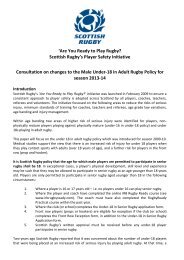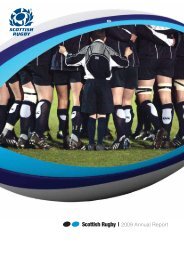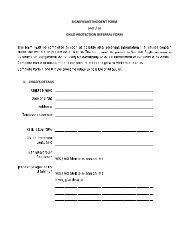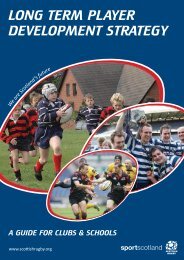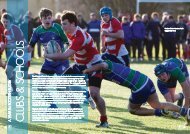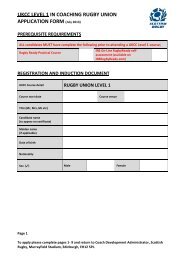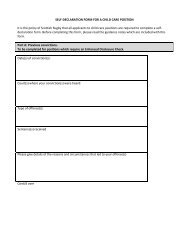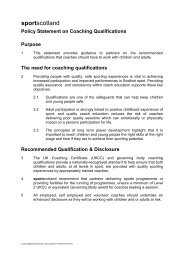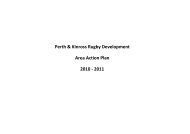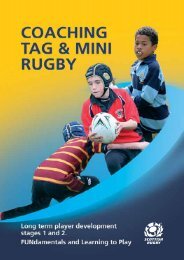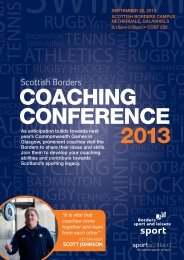LTPDst3cover.qxd (Page 1) - Scottish Rugby Union
LTPDst3cover.qxd (Page 1) - Scottish Rugby Union
LTPDst3cover.qxd (Page 1) - Scottish Rugby Union
- No tags were found...
You also want an ePaper? Increase the reach of your titles
YUMPU automatically turns print PDFs into web optimized ePapers that Google loves.
DRIFT DEFENCEDrift / push defence. In the drift/push defence, defenders use the touchline as an additionaldefender.. The first movement is always forward - line-speed is key to any defensiveapproach. If defenders fail to get off their line quickly and pressurisethe defence then it is likely that the attack will get over the gain line.Key factors of a drift/push defence:1. Defenders line up facing the inside shoulder (the shoulder closest to thebreakdown) of the attackers. Lining up on the outside shoulder createsspace on the inside of the defender.2. Defenders in ‘active’ position (split stand ready to accelerate off the line,hands up ready to make a tackle, talking to each other to organisespacing between defenders).3. The inside defenders (nearest the breakdown) lead the go-forward offthe line. Players need to keep their inside defender slightly in front ofthem at all times to ensure no dog-legs occur in the defensive line.4. Once ball is passed, defenders drift/push onto the next attacking player.Drifting too early (i.e. before the ball has been passed) will create gapsin the defensive line for attackers to exploit.5. Defenders to keep their chests and hips facing the attacking line. If hipsare angled towards the touchline, then this can create a ‘weak-shoulder’on the inside.SET UPBall passed to 1st receiverBall passed to 2nd receiverRUCKRUCKRUCKActivity Drift / push defenceObjective Develop the ability of your players to understand the roles andresponsibilities of defenders when operating a drift/push defence.Key Factors1. Defenders align themselves on the inside shoulder of their nominated attacking player.2. Defenders start in an active position with a split stance and loud, accurate communicationbetween each other. 3. The first movement in a drift/push defence is forwards - aim to gainterritory and close the space. 4. The defensive line is lead by the first defender, closest to theruck - players should stay behind their inside man in a drift/push defence - this prevents doglegsin the defensive line. 5. Once the ball is passed, a call of ‘push’ is made by the insideplayers. Defenders then drift onto their next available attacker, always ensuring they arealigned with the attacker’s inside shoulder.Equipment RequirementsBalls 4 Bags n/a Area min 25m widthCones 16 (3 colours) Suits 3 Players 13Shields n/a Bibs n/a Time 15 minsPractice DescriptionThree defenders in tackle suits versus five attackers (two groups in orange). Defenders starton the cones nearest to the attackers.Once the ball is passed, defenders run backwards to the green cones and begin theirdefensive duties. Attackers are initially instructed to attack using simple passing along theline. Defenders operate a drift defence to stop the attackers scoring past the red cones.Once the attack has finished, the defenders turn 180 degrees and play against the nextattack.RUCK RUCKSET-UP DIAGRAM25mPractice Progression / RegressionsProgress - increase the number of attackers to challenge defence.Progress - allow the attack to use more attacking options.Regress - reduce the amount of attackers or remove completely.84



